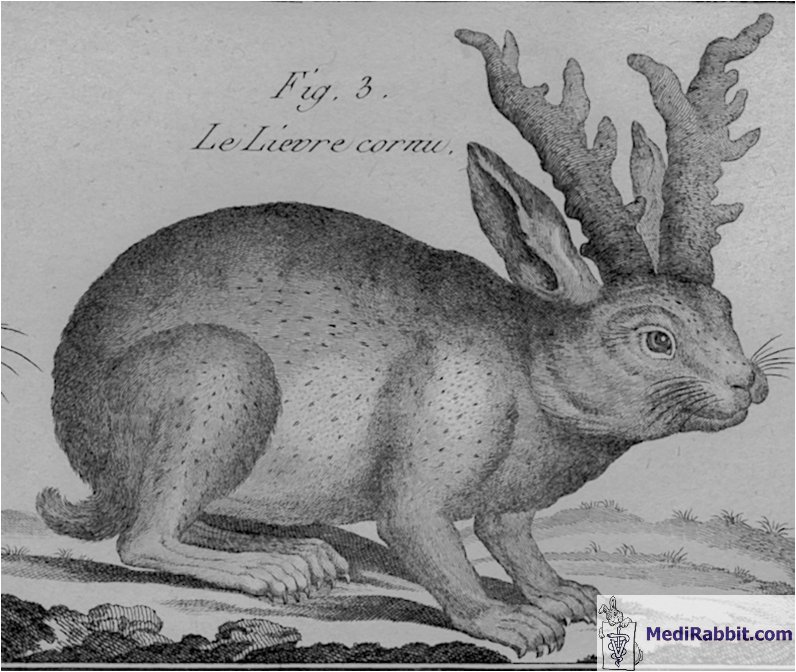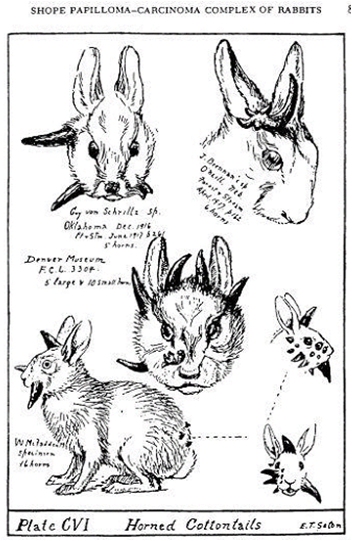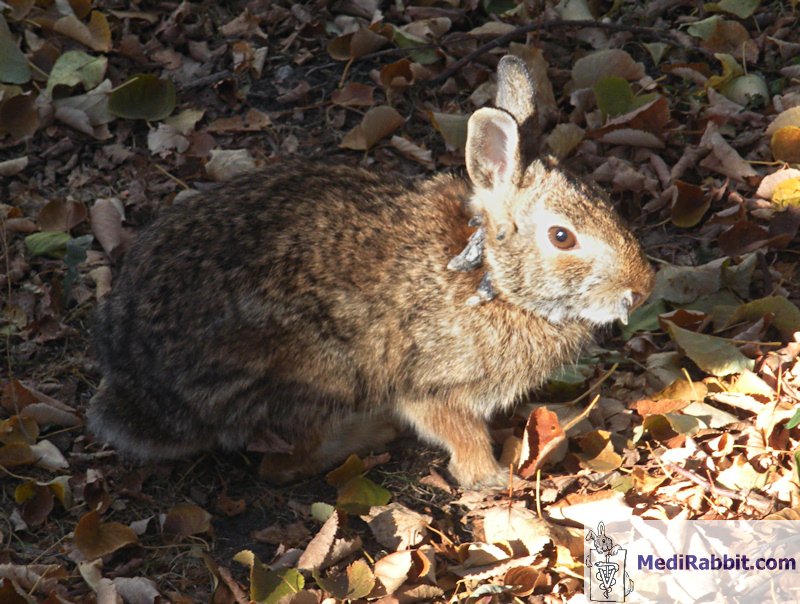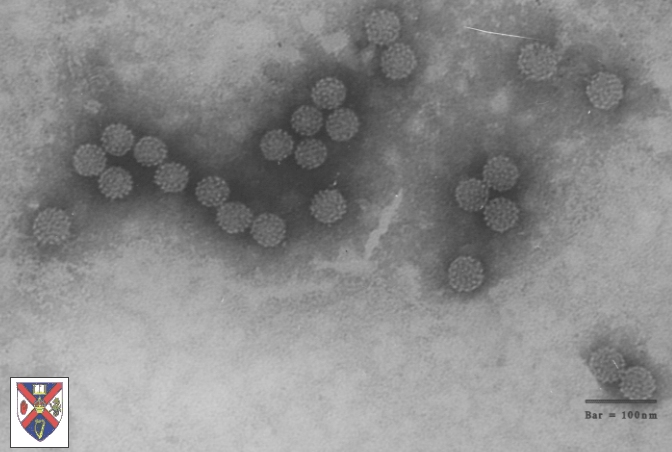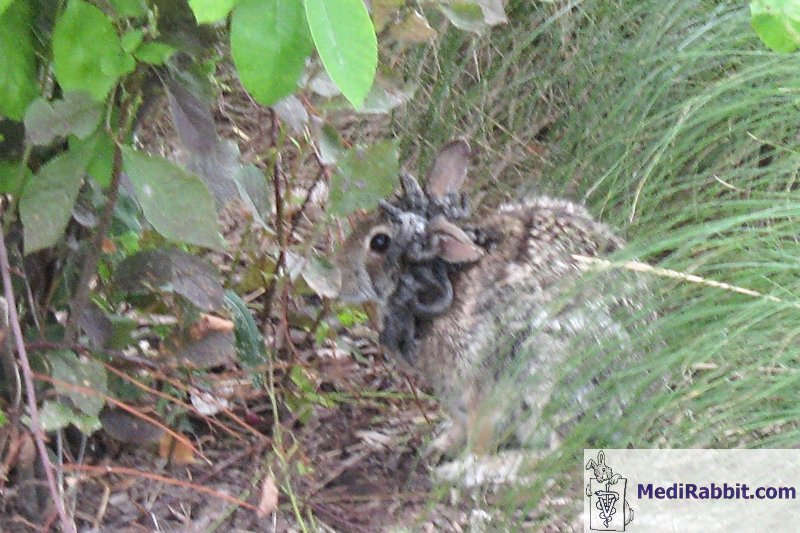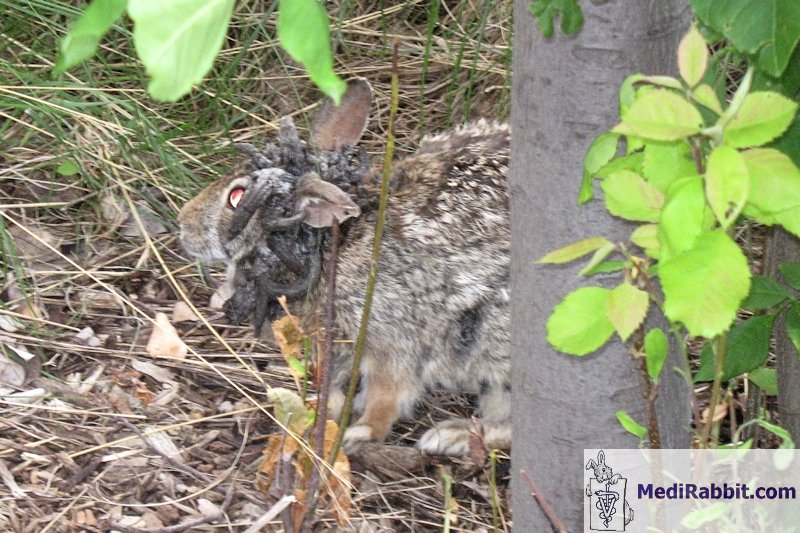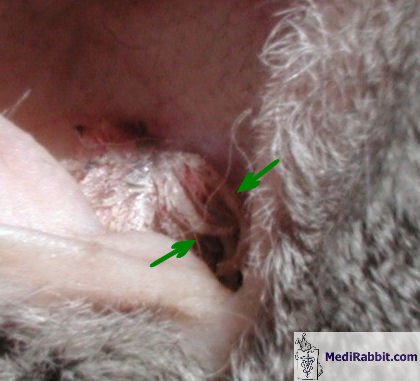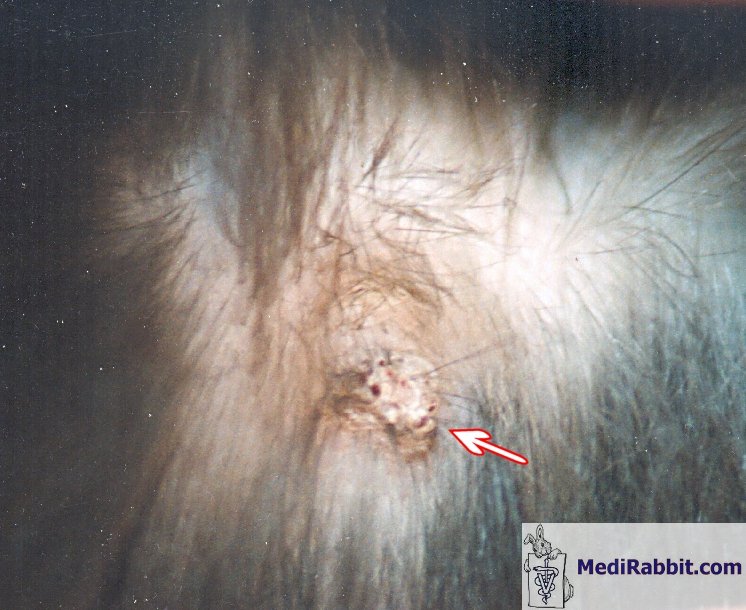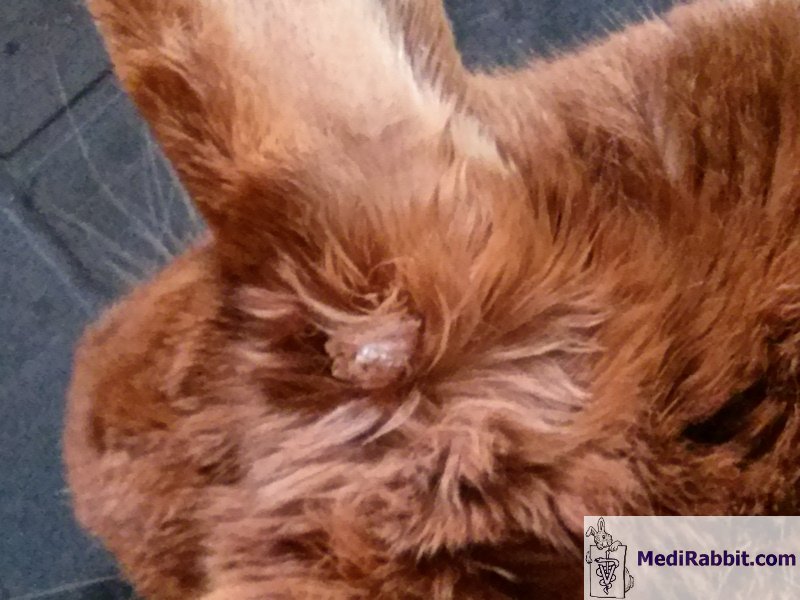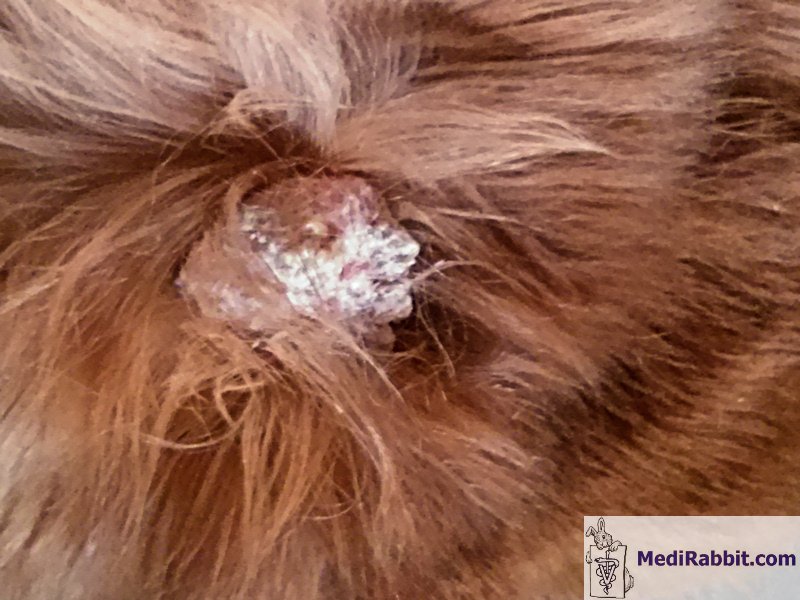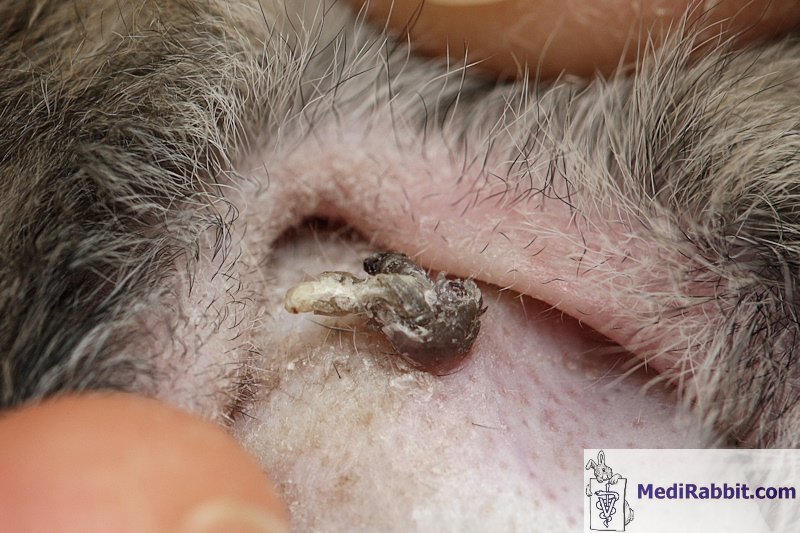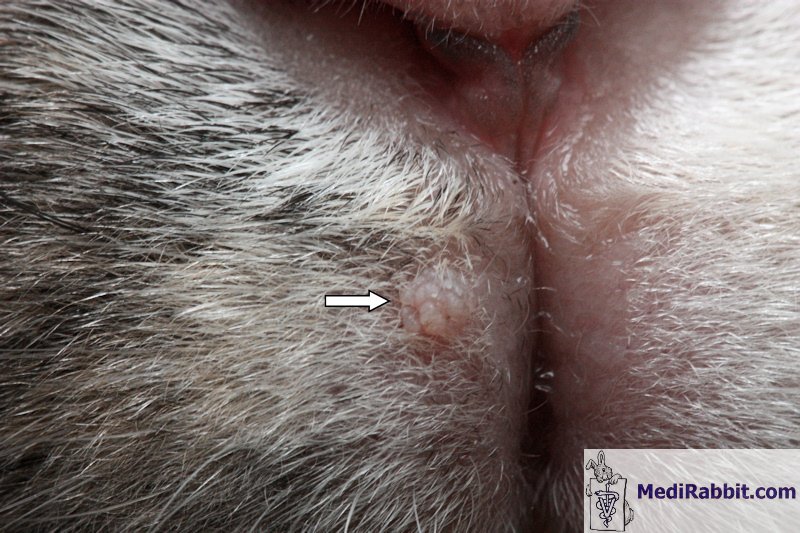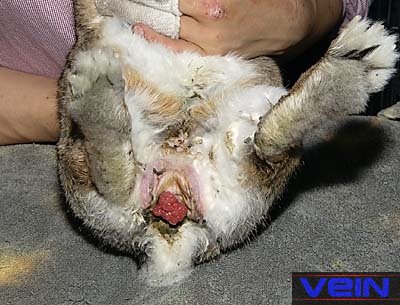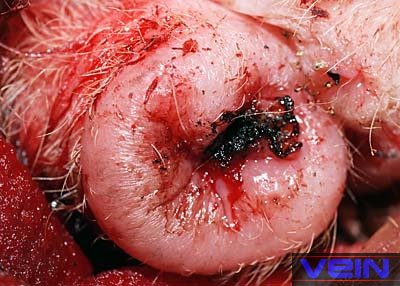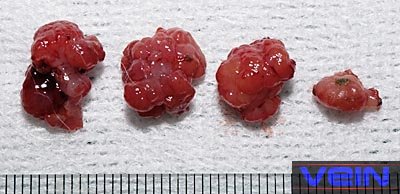Do horned
rabbits really exist ? - Papillomatosis
Esther van
Praag, Ph.D.
|
MediRabbit.com is
funded solely by the generosity of donors. Every
donation, no matter what the size, is appreciated and will aid in the
continuing research of medical care and health of rabbits. Thank you |
Warning: this file contains pictures that may be distressing to some persons
When legend meets science...
Between the 16th and
the 18th century, illustrations show the legendary horned rabbit, a
hypothetical cross between the antelope and the hare. The horned animal was
studied by several naturalists, who gave it the Latin scientific name Lepus
cornutus.
It is, nowadays, alleged that the
"horned" head of Lepus cornatus
does not relate to imagination, but to the presence of papilloma or fibroma tumors. These skin tumors develop after
infection of a cell by the infectious Shope papilloma virus.
Shope papilloma virus
Shope discovered the benign
papilloma virus in the USA, in cottontail rabbits (Sylvilagus sp.). It
occurs as a natural disease in the midwestern USA
mainly, but has also been reported elsewhere. The disease can spread to
snowshoe hares (Lepus americanus),
jackrabbits (Lepus californicus) and house
rabbits (Oryctolagus cuniculus).
The
Shope papilloma virus is a DNA virus, with properties identical to those of
the papovavirus family. Initially, the virus was
not believed to cause harm; later it was discovered that their presence could
lead to the development of malignant tumors. Ticks, mosquitoes, and bugs seem
involved in the spread of the virus. The involvement of mosquitoes is
demonstrated by the fact that the papilloma develops mostly on “naked” body
parts of the rabbits, e.g. ears, eyelids, nose and anus.
The tumors are generally devoid of infectious
virus; yet, transmission appears possible from rabbit to rabbit.
Clinical signs and
diagnosis
The
Shope papilloma virus will infect and transform a follicular cell, leading to
a red swollen appearance of the skin. It starts as a reddish spot on the site
of infection. The first apparent signs are the formation of a circular
papilloma, which may become a keratinized horny wart. They are mainly
observed on eyelids, on the head or at the base of the ears.
The
diagnosis for papilloma is based on the disease symptoms and will be
confirmed by histopathological studies of the tumor.
Surgical excision with a wide
margin is the best option to remove papilloma warts. If the tissue is not
fully removed, recurrence is possible. If left untreated, the wart may
regress naturally, yet, about 25% of papillomas become malignant (cancer like) and develop
into squamous cell carcinoma. Metastases are prone to develop in the lymph
nodes and the lungs. At an advanced stage of the disease, the kidneys and the
liver become affected as well.
A further type of papilloma virus
can plague the domestic rabbit: oral papilloma virus, which is distinct from
the Shope papilloma virus, and is characterized by the development of tumors
in the oral cavity only. The oral type will not be discussed here.
Treatment
Surgical removal of the tumor is the treatment of choice. Ablative
methods include the classical surgical excision or destruction by laser, electrodissecation or liquid nitrogen. Cutaneous
papillomas are different from rectal papilloma. The
latter is located at the anus. When their size is large, or they start
bleeding, it is important to remove the entire wart as well as tissue that
attach the wart to the rectum (peduncles) to avoid recurrence.
For detailed information on papilloma in rabbits, by E. van Praag, A. Maurer and T.
Saarony, 408
pages, 2010. Acknowledgement
Many
thanks to Ray Sedman (USA), Tiffany Adams (USA), Dr Shannon J. Fisher, Christine Ozouf (FR), Arie van Praag (CH) and to Akira
Yamanouchi (VEIN, Veterinary Exotic Information Network) for the permission to use their pictures.
Further Reading
Giri I et
al.1985. Genomic structure of the cottontail rabbit (Shope) papillomavirus.
Proc Natl Acad Sci USA
82: 1580-1584. Hagen KW. 1966. Spontaneous
papillomatosis in domestic rabbits. Bull Wildl Dis Assoc 2: 108-110. Kidd JG, Rous P. 1940. Cancer
deriving from virus papillomas of wild rabbits
under natural conditions. J Exp Med, 71: 469-493. Kreider, J.W. and
Bartlett, G.L., 1981, The Shope papilloma-carcinoma complex of rabbits: A
model system of neoplastic progression and spontaneous regression, Adv. In
Cancer Res., 35: 81-110. Larson CL et al.1936. Transmission
of rabbit papillomatosis by the rabbit tick, Haemaphysalis
leporis-palustris. Biol
Med 33: 536-538. Phelps WC et al.1985. Shope
papillomavirus transcription in benign and malignant rabbit tumors. Virology
146: 120-129. Rous P, Beard JW. 1934. Carcinomatous
change in virus-induced papillomas of the skin of
the rabbit. Proc Soc Exp Biol Med 32: 578-580. Rous P, Beard JW. 1935. The
progression to carcinoma of virus-induced rabbit papilloma. J Exp Med 62: 523-548. Seton, E.T., 1937, Lives of Game
Animals, Vol. IV:787, Literary Guild of America, New York Shope RE. 1935. Serial
transmission of the virus of infectious papillomatosis in domestic rabbits.
Proc Soc Exp Biol Med 32: 830-832. Shope RE. 1937. Immunization of
rabbits to infectious papillomatosis. J Exp Med 65:
607-624. Shope RE, Hurst EW. 1933.
Infectious papillomatosis of rabbits. J Exp Med 58: 607-624. Schott, Gaspar, 1667. De Lupo, & variis ejus speciebus, Physica curiosa, Second
Edition. Syverton JT. 1952. The
pathogenesis of the rabbit papilloma-to-carcinoma sequence. Ann NY Acad Sci
54: 1126-1140. |
|||||||||||||||||||||||||
e-mail: info@medirabbit.com



